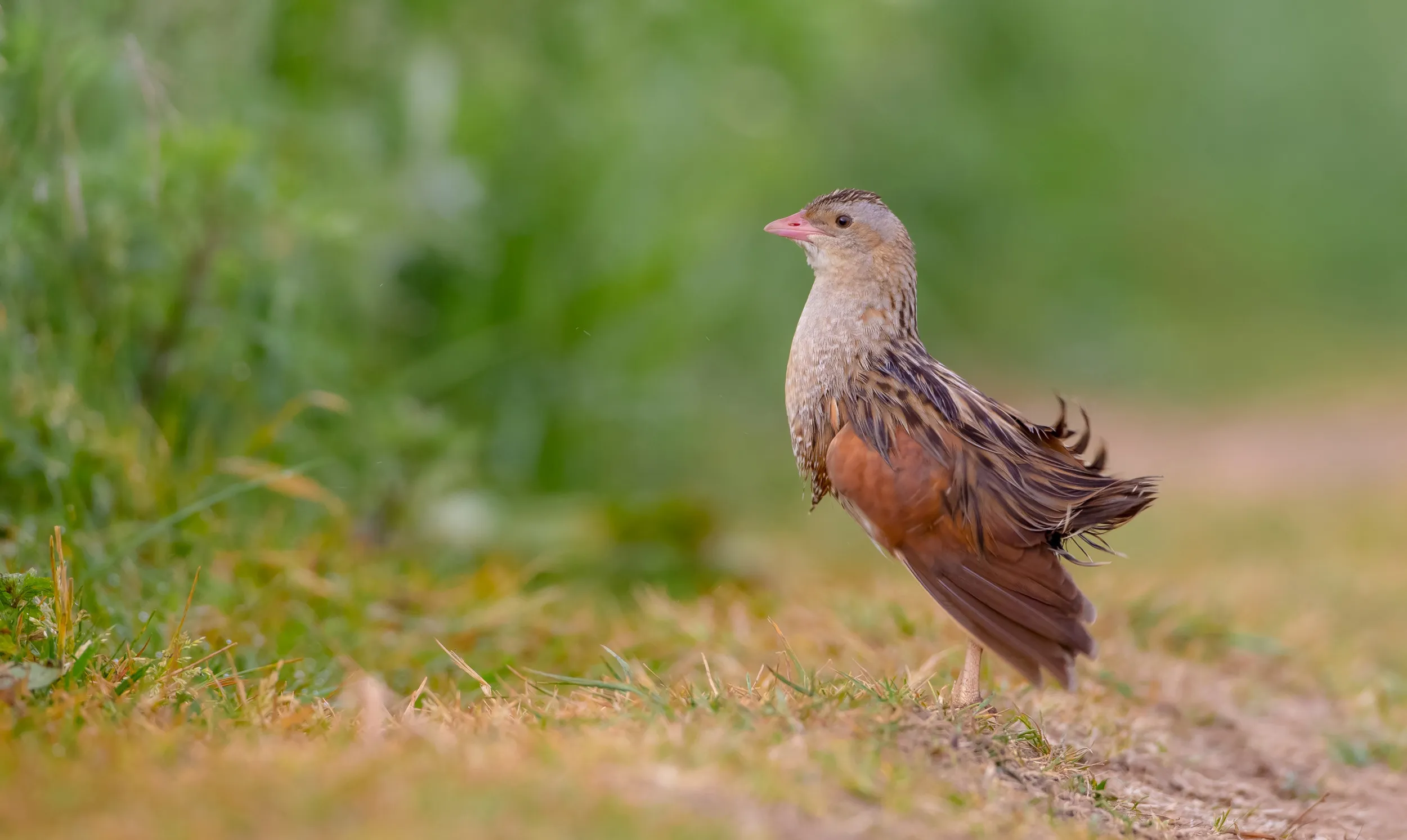Corncrake Calling
Supported by The National Lottery Heritage Fund, Corncrake Calling is a four-year project to save these small brown secretive birds in Scotland.

On this page
Once widespread across Scotland, Corncrake populations have fallen dramatically as farming and agricultural production have intensified. They are now found only on some Scottish islands and in parts of the northwest coast of Scotland, with populations having declined in recent years.
Corncrake Calling includes three key workstreams: building on the longstanding work with farmers and crofters to increase the area under positive land management; engaging and educating the public about the species and the vital role of farming in its survival; advocating for future rural development policies which better support farmers and crofters who farm in a nature and climate-friendly way.
About Corncrakes
The conservation status of the corncrake remains precarious. Corncrake Calling is essential to ensure the future of this iconic and secretive species in Scotland, protect other wildlife and help preserve the unique culture of rural Scottish communities. Corncrakes are secretive birds with a very loud voice. On arrival into Scotland from Africa the crex-crex call of the males rings out continuously from long vegetation until they attract a mate.
Read all about it
For more information and real-time updates about the project head to our Corncrake Calling community pages.
Seen or heard a Corncrake?
We need your help. If you’ve seen or heard a corncrake, report it here and upload your photo or audio recording.
- You can log your observations in this simple form here.
- Plus explore the Corncrake Calling interactive observations map as seen below.

Land management
RSPB Scotland has been working with crofters and farmers for decades to improve management for Corncrakes and other wildlife and provide support with farmland bird and ecological surveys. Management focuses on, firstly, increasing the area of suitable tall vegetation, ensuring that sufficient cover is available in spring/autumn to conceal Corncrakes and, secondly, delaying the mid-summer mowing date and mowing fields in a Corncrake-friendly way to allow flightless chicks to escape.
These rare birds need sympathetic land management to survive.
Small changes making a big difference
Watch the videos below to discover how farmers are innovatively finding Corncrake-friendly methods to preserve habitats for these small birds.
Meet the team
Skye: Shelagh Parlane
Shelagh has been pivotal to RSPB Corncrake conservation on Skye. She has dedicated over 11 years to working in the community. Always enthusiastic and happy to help, what she doesn’t know about toppers and limers (tractor implements for Corncrake conservation) isn’t worth knowing.
Most of her work is based on Waternish; a peninsula on Skye, where the Landscape is characterised by small crofts and crofting townships, but she is happy to support crofters across the whole isand. “Small changes can make a big difference”.
When she is not driving about in a tractor she can be found making cinnamon buns and enjoying an espresso. shelagh.parlane@rspb.org.uk


Lewis & Harris: Shona Morrison
Shona is a Corncrake warden on Lewis & Harris. She works with crofters implementing Corncrake conservation management across Lewis, based mainly in Ness.
She is working with local graziers to encourage more cattle and sheep onto areas for the benefit of wildlife and summer nights are spent out surveying the Corncrake. She also manages a group of enthusiastic volunteers who to help create Corncrake habitats.
Shona is Lewis born and bred and when she is not seeing to her horses every needs, she can be found walking her dogs on the moors, machairs and beaches. shona.morrison@rspb.org.uk
.png)
Argyll: Louise Muir
Louise made the Hebrides her home in 2004 and for 12 years she was managing Smaull Farm, an RSPB reserve dedicated to low intensity and high nature value farming. Since November she has been working with crofters and farmers in Argyll to help improve the fortunes of the rare and noisy corncrake.
She also assists with entrance into agri-environment schemes working alongside the Scottish Agricultural College. “Often all it takes is someone to look at and with a different perspective to see the opportunities for wildlife conservation alongside a farming operation”.
Community ceilidhs, local gins and wild swimming keep her occupied when she is not working. Louise.muir@rspb.org.uk
Uist and Barra: Claire
Claire moved to Benbecula in 2018 after falling in love with Uist during many holidays.
With nearly 30 years of experience as a ranger, she secured the role of Warden for Uist and Barra with RSPB in 2020, allowing her to continue sharing her extensive knowledge and enthusiasm for nature. Although she has spent a long time working with nature, she believes there is always more to learn, especially in a unique place like the Outer Hebrides.
Claire's love for the outdoors and interest in wildlife and foraging began during her childhood. Family wild camping holidays involved eating blaeberries and wood sorrel, swimming in rivers, and cooking over open fires, which cultivated her passion for nature from a young age.
Project Manager: Tara Proud
Tara joined the team in April 2023. She is leading the project from her home on the Isle of Lewis. She is fascinated by long-distance migration and loves getting out and about to hear and see Corncrakes whenever she can.
Previously, Tara worked at the Marine Conservation Society for six years, where she led volunteer management, community engagement, and education initiatives for the charity across Scotland and Wales. Before that she worked at RSPB for 5 years, managing Operation Turtle Dove. Tara started her career volunteering as a field biologist with the Mauritian Wildlife Foundation.
When not at her desk, she enjoys trail running, photography, wild swimming and exploring the Western Isles with her family. tara.proud@rspb.org.uk





